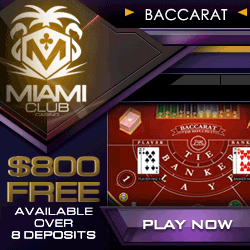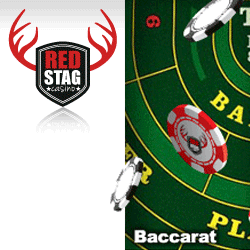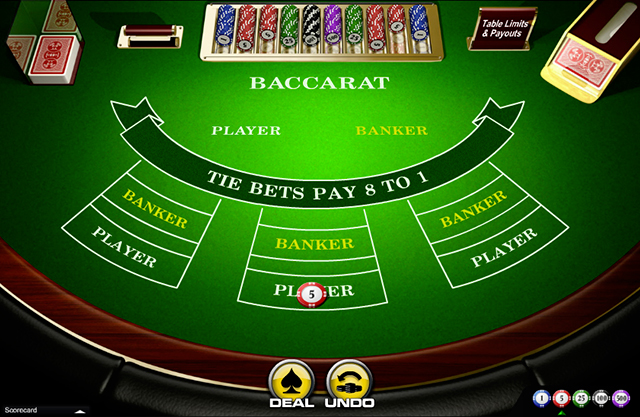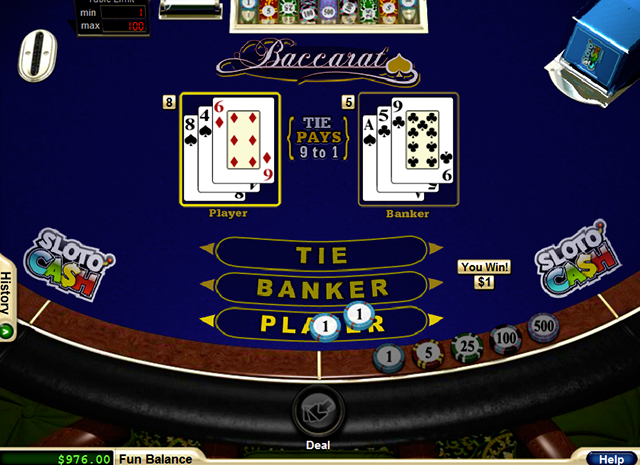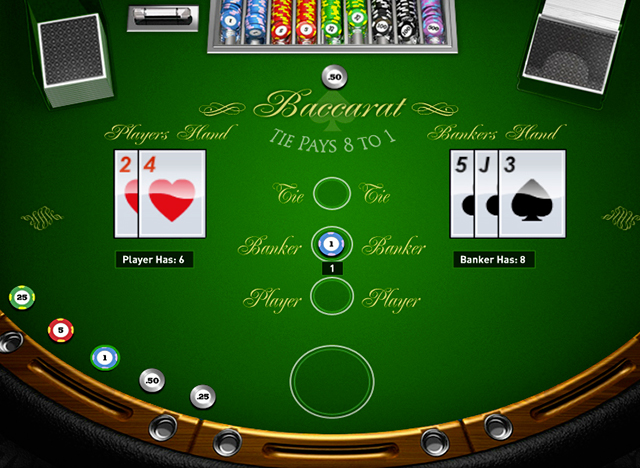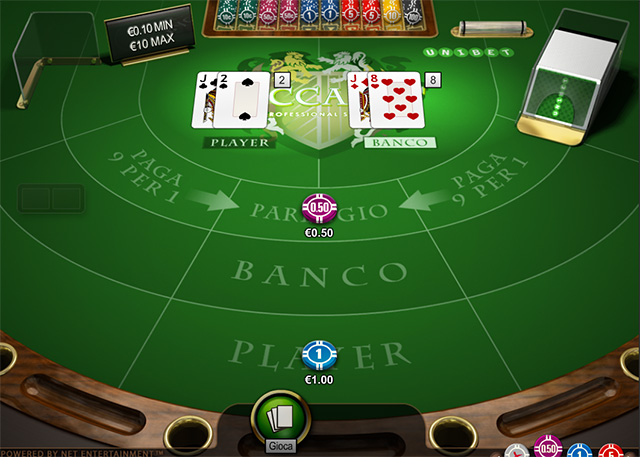
Created in Italy but made famous by the French, Baccarat is one of the first games to enter all the casinos. There are several different versions of Baccarat, some of them hosted by online casinos such as "chemin de fer" and "mini baccarat". For the rest, Baccarat is typically a game of chance.
Baccarat is a game every good online casino should provide. Not just a single game, but rather a “family” offering three variants of table games played against the banker: “punto banco” (or “North American Baccarat”), “baccarat banque” and “chemin de fer”. Even though these games are individual, “punto banco”, “baccarat banque” and “chemin de fer” conventionally joined together under the generic name of “Baccarat”. “Baccarat banque” and “chemin de fer” are very similar since they both give the player the opportunity to choose and somewhat affect the result of the game. On the contrary, the dealer point is definitely a game of chance, since each player’s move is determined by cards only. In Baccarat, six or eight 52-card decks are generally used.
Baccarat: the history
Unlike other casino games whose origins are wrapped in mystery, myths and legends, the evolution of Baccarat followed a linear path. Though not yet confirmed, Baccarat seems to have Italian origins. However, it moved to France where was fully approved.The Italian name of this game is baccarà, but it obviously took the French phonology as it moved to France: many French words, in fact, end with a silent consonant; the name “baccarat” is just an example.
Charles VIII the Affable is considered the supposed father of Baccarat. During his reign (from 1483, when he was only 13, to his death in 1498), was the boom of Baccarat, especially played in court. That’s why Baccarat was regarded as a royal game for many years, ranked a bit higher than the other casino games. Probably Carlo VIII liked this game because he was only a kid who used to enjoy recreational activities.
After its outbreak, Baccarat invaded European and later even world playhouses and casino games, though it has been long ranked as a rich man’s game. Later, with the advent of online casinos and the wide spread of casino games, Baccarat became a popular game.
Baccarat appeared also in literature, cinema and videogames. As the fans of Fleming’s books know, Baccarat was the favorite pastime of James Bond, the worldwide famous secret agent holding a license to kill. Baccarat is even the main theme of an entire book dedicated to James Bond called “Casino Royale” which became a film in 1967.
References to Baccarat are also found in “Rush Hour 3”, an American action comedy; Baccarat appears in some scenes, where the main character mistakes it for Blackjack and poker. Finally, Baccarat appears in “Team Fortress 2”, a videogame which teens like very much.
Some images related to the game of Baccarat
Video demo-match at Baccarat
Baccarat rules
Baccarat rules follow a specific pattern: the banker and his opponent’s actions are fixed and they can’t be interpreted nor chosen. Baccarat is played with six (or eight) 52-card decks without jokers. Both the player and the banker are drawn two cards each with a nominal value, from 1 to 9, whilst face cards and 10 are worth 0 points. In multiplayer Baccarat, the players who are not involved in the challenge against the banker may bet on banker, player or tie.
Baccarat includes three versions with the same rule system: “punto banco”, “chemin de fer” and “banque”. What is most striking is not just the dynamics of Baccarat game, but the opportunity to influence more or less heavily the result through a series of choices that won’t change Baccarat rules, whichever version you may be playing.
That’s why we can talk of Baccarat rules in general, regardless of the differences between “chemin de fer”, “punto banco” and “banque”.
However, “punto banco” with the player and the banker as the two opposing sides is the virtual version played in the online casinos. In land-based casinos you can play all the other Baccarat versions, with 14 players at one time!
But now let’s see Baccarat rules. Baccarat is usually played with six or eight 52-card decks. The cards are ranked in ascending order: ace (the lowest card) is worth 1 and 9 is worth 9; unlike other card games, 9 is the highest score. 10 and all face cards, in fact, have no value in Baccarat.
At the start of a hand, the banker deals two cards to the player and to himself. The player checks the result of his hand and plays according to the hand’s value:
- Whether the total is of 8 or 9 points, the hand is over. The player has a hand called "natural" and wins, unless the banker won’t tie (or make a better “natural”, too).
- Whether the total is of 7 or 6 points, the player can’t draw any more cards, but has a "natural".
- Whether the total is of 2, 3, 4 o 5 points, the player receives a third card. However, the player’s score may exceed 9 points with a third card. Baccarat rules prevent this possibility: if that happens, ten points will be subtracted to the total.
At the end of player’s turn, the banker starts to play following this specific scheme:
- If the banker has 7 points, he doesn’t draw any more cards.
- If the he has 6 points and the player’s third card is 6 or 7, the banker draws a card.
- If the he has 5 points and the player’s third card is 7, 6, 5 or 4, the banker draws a card.
- If he has 4 points and the player’s third card is 7, 6, 5, 4, 3 or 2, the banker draws a card.
- If he has 3 points and the player’s third card isn’t 8, the banker draws a card.
- In any other case (2, 1 or 0 points), the banker draws a card.
The object of the player is to beat the banker’s score. If he wins, his reward will be two times bigger than the total sum wagered. That’s how classic online “player versus banker” Baccarat is played. In multiplayer version, the players may choose to wager on banker, player’s opponent, or tie. In the first two cases the win is 1:1, in case of a tie, the player’s reward is eight times bigger than the sum wagered.
Baccarat Versions
| Variant name Baccarat | Brief description |
|---|---|
| Baccarat “Punto Banco” | Baccarat “Punto Banco” is the most popular Baccarat version in gambling world. The banker/dealer never change hands in this game; though just institutional, this role is played by the house. On the other hand, the players have just to attend to the gaming operations performed by the croupier or software, in case of “live” or online casino, betting on point (namely, the player’s hand), banker (casino’s hand) or tie. Player and banker pay equal, whilst tie pays eight times more than the total sum wagered. |
| Baccarat Gold | “Baccarat Gold” is one of the Gold games developed by Microgaming, leading company in the development of online gambling products. Baccarat Gold has been designed using the latest technological expedients for casino games; this game, in fact, boasts accurate graphics and great interactivity. Moreover, Baccarat Gold is similar to the most popular Baccarat version, “Punto Banco”, though “Baccarat Gold” boasts a wider range of special features and rich additional bets. Baccarat Gold is played by eight card decks and the player can bet from 5 to 500 credits. |
| Baccarat « Chemin de Fer » | Baccarat “Chemin de Fer” is the original version of Baccarat. “Chemin de Fer” is hard to find in the online casinos since the role of the banker (dealer) is performed by all players in turn. However, the rules are similar to Baccarat: the player who gets closer to 9 points wins the hand. In Baccarat “Chemin de Fer”, though, the banker decides on the amount he wants to wager, and the players have to end with the same amount of points as a tie (otherwise, a group of players called “observers” can take part in the hand; observers are those players who are waiting for their turn sitting at the table). |
| Baccarat Banque | “Baccarat Banque” is a Baccarat version, very similar to “Chemin de Fer”. One of the players sitting around the table is the banker: the other ten players are divided into two teams and sit on either side of the banker. Both the banker and the players have to get the highest score possible beating their opponents. As for “Chemin de Fer”, in “Baccarat Banque” the banker decides on an amount to bet and compares his hand with the hands of two opponents: the player at his left and the player at his right. |
| Mini Baccarat | Mini Baccarat version is less formal and easier than “Punto Banco”. Mini Baccarat is provided by online and, sometimes, land-based casinos and allows his players to enjoy this game without spending too much money. In fact, the house edge is lower in Mini Baccarat than in other similar games. Furthermore, the layout of Mini Baccarat table is simple, compared to other casino table games. The rules are the same as “Punto Banco”, with the croupier acting as the banker. Nothing to add, except that a typical Mini Baccarat table may accommodate up to a maximum of seven players at one time. |
Baccarat glossary
A comprehensive understanding of Baccarat terminology is the very first step you need to take before trying this game. First of all, you should be able to distinguish between the most popular versions; in fact, “Punto Banco”, “Chemin de Fer” and “Banque” are quite similar but not identical, since they differ in some details. Moreover, “natural” is a very important term to be familiar with, since it indicates the highest score achieved in any Baccarat version. “Natural” is also known as "Le Grand" (a French word).
- “A”
- Apartment. regular player who places the same bet in every round.
- “B”
- Baccarat. The name of this game, but also a hand or a card having a value of 0.
- Banque. Another Baccarat version.
- Banker. The dealer or the player who substitutes the dealer/ Betting on the dealer.
- Burn card. The card removed during shuffling.
- “C”
- Chemin de fer. Another Baccarat version.
- Cheval. Disused Baccarat version which gave the opportunity to play two hands at one time.
- “D”
- Down card. A face-down card which can’t be viewed by all players.
- “F”
- Face card. A card showing a picture i.e. Jack, Queen or King. Such cards have a value of 0 points in Baccarat.
- Flat bet. Making the same bet each and every hand. Often refers to "apartment" player. A sort of wordgame.
- “H”
- Hand. The player’s or banker’s cards.
- House advantage. The casino advantage over the players.
- High Roller. A player who makes large bets.
- “L”
- Le grand. French word to indicate the best natural hand, a 9 on the first two cards dealt.
- “M”
- Mini baccarat. American version of Baccarat played on a smaller table.
- Monkey. The lower cards: 0-valued face cards (Jack, Queen and King) and 1-valued ace.
- “N”
- Natural. A score of 8 or 9 points on the first two cards.
- Player. The main banker’s opponent or the player’s winning bet.
- Punto banco. Another Baccarat version.
- “S”
- Sabot. Virtual or land-based dealing box holding card decks.
- Shuffle up. Shuffling cards before a new hand.
- Standoff.The player and banker tie. See also “Tie”.
- “T”
- Tie. The player and the banker have the same hand. See also “Standoff”.
- “U”
- Upcard. A card displayed face-up for everyone to see.
Baccarat tricks and strategies
The chancy nature of Baccarat is an obstacle for strategies and tricks. Baccarat, in fact, is a game of chance and the results cannot be produced neither by player’s nor by banker’s moves. A specific scheme is followed in Baccarat: after having drawn the first two cards, the players may draw or not draw other cards according to the player’s score or the score of the banker’s opponent.
However, some strategies may have positive effect on the expected value of long-term bets rather than on the results. The best Baccarat experts, for example, suggest to bet on the banker because he has more winning chances than the player. Sometimes, land-based casinos use an additional fee on the winnings for the bets placed on the banker, since they are the most common bets.
Anyway, Baccarat odds may vary or the game might be boring (at least for players who are not challenging the banker). It is possible to bet on the player though he has less winning chances than the banker. On the contrary, tie bets between the banker and the player may be very risky, even if they pay best. Although this kind of bet pays very well, statistics show that the probability of winning is less than 10%.
So, a good strategy to win Baccarat is the bet progression system: Once the player has chosen a sum, he places his bet and, if he wins, the profit is the same as the size of his last bet. In case of negative result or four positive results the game will restart. Online roulette players are often familiar with this strategy because it is clearly influenced by the famous Paroli system. Another Baccarat strategy is to bet always on the player who won the last hand. In short, if a player won the hand, the other player will bet again on him, but if the banker is the winner of the last hand, the player will bet on him. However, this strategy is not statistically or mathematically proven.


